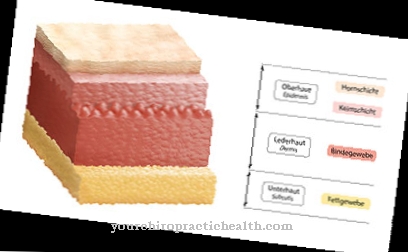Of the Ski thumb refers to a tear on the inner collateral ligament of the thumb. This injury is typical of skiers, but is also common in ball games. A skier's thumb must be treated, otherwise the thumb will lose its functionality.
What is a ski thumb?
.jpg)
© tonaquatic - stock.adobe.com
As Ski thumb This is colloquially known as a tear in the collateral ligament at the base of the thumb. The medical term for this is ulnar (on the ulnar side) collateral ligament rupture (rupture = tear) or Rupture of the ulnar collateral ligament.
The ulnar collateral ligament, along with other ligaments and structures, stabilizes the metacarpophalangeal joint of the thumb and runs on the side of the thumb that points towards the rest of the fingers. If the thumb is extremely splayed away from the hand, this leads to an excessive stretching of this side ligament. If the load capacity of the tape is exceeded, it will tear.
The term ski thumb comes from the fact that this collateral ligament tear often happens to skiers when they fall and try to catch themselves with their hands or when their thumbs get caught in the loop of the ski pole. In both cases, the thumb is overstretched towards the spoke. The tear can occur in three different places on the tape; close to the metacarpal phalanx, in the middle or close to the metacarpal bone.
causes
The cause of the Ski thumb is excessive spreading of the thumb from the hand and the associated overstretching of the lateral ligament at the metacarpophalangeal joint. Very often this happens when skiing.
But a skier's thumb can also occur in other sports. If a ball thrown with force is caught in ball sports, the thumb can also be stretched back so far that the side ligament tears.
Other possible causes for the skier's thumb are a fall, which one catches reflexively with the spread hand, the overstretching of the thumb in floor or apparatus gymnastics as well as in martial arts.
Symptoms, ailments & signs
A rupture of the collateral ligament causes a variety of complaints. A distinct crack can often be heard during the accident. Immediately afterwards there is a sharp shooting pain in the thumb and in the metatarsophalangeal joint. Since a torn ligament also affects the surrounding tissue and vascular injuries occur, blood leaks into the tissue and a bruise forms (hematoma).
This in turn leads to swelling of the thumb and increased sensitivity to pressure, especially in the metatarsophalangeal joint. The joint is unstable, can move abnormally and can be opened. If it can be opened up to more than 30 °, this is a significant indication of a collateral ligament tear. The thumb feels weak and also folds to the side when moving, so that it cannot be used or only to a limited extent for grasping and pressing.
Any attempt at a grasping movement is painful. If the accident takes place on the slopes, the person affected immediately notices that he can no longer hold the ski pole. After a few days, the pain subsides, but permanent discomfort can occur if the injury is not treated. If the thumb remains unstable, the thumb base joint is overloaded over time and unphysiologically worn, which can lead to joint wear (osteoarthritis). It is also possible to stiffen the joint.
Diagnosis & course
Of the Ski thumb is immediately noticeable by shooting violent pain. Sometimes a popping sound can be heard when the tape breaks. After the accident, the thumb joint is no longer stable.
The thumb has a sideband both inside and outside. If the inner side ligament is torn, the thumb can be opened outwards. Since the torn ligament and possibly other injured structures bleed, a bruise (hematoma) forms after the rupture and the tissue around the thumb swells. After the first violent shooting pain, a permanent pain develops in the further course. A gripping movement with the thumb is no longer possible and every movement hurts.
The doctor usually suspects a collateral ligament tear as a result of the accident and the fact that the thumb can be opened. A mobility test is always difficult because it causes pain. An X-ray can be used to clarify whether there are additional bony injuries. With the MRT examination (magnetic resonance tomography), the skier's thumb can be diagnosed without any doubt, as the structures of the ligament are also visible here.
Complications
A skier's thumb is primarily noticeable through severe pain. Further complications can arise if the injury is not treated promptly. This can result in permanent thumb movement restrictions. Symptoms of paralysis and sensitivity disorders are also typical. A bruise can cause skin damage or frostbite if handled incorrectly.
It can also lead to inflammation, which in the worst case results in a scar on the heel of the hand. Otherwise, the collateral ligament itself does not pose any risks. However, it always leads to restricted mobility, which significantly restricts the person concerned in everyday tasks. Careless behavior can cause the injury to reopen and need to be treated again. The main complications and risks of surgical treatment of a collateral ligament are possible infections.
These are usually expressed in swelling and redness in the surgical area, combined with pain and impaired sensitivity. In individual cases, skin nerves can be injured in the area of the procedure. As a result, knot-like thickenings can form, which are associated with sensory disorders and other complaints. Prescribed pain relievers occasionally cause side effects and interactions.
When should you go to the doctor?
In addition to the mouse arm, tennis elbow or snowboarder's ankle, the skier's thumb is also a typical sports injury. The rupture of the collateral ligament of the thumb is more common in skiers. However, it can also occur in all other sports accidents in which the thumb has been spread wide apart.
The collateral ligament (torn) is due to the severe overstretching. Occasionally a piece of the thumb bone is also affected. Either way, the doctor should be visited as soon as possible after the accident, because the thumb is indispensable in our lives. Immediately after the accident, it is advisable to immobilize the thumb or the entire hand. Cooling is also useful. It prevents severe swelling.
A quick visit to the doctor is indispensable because non-compliance can cause consequential damage. Untreated injuries can lead to osteoarthritis of the thumb joint, permanent malalignment of the thumb or permanent joint instability with permanent pain and restricted mobility.
In most cases an operative repair of the ski thumb is necessary. In some cases, conservative splinting and immobilization may be sufficient. However, this is only possible if it is overstretched or cracked. If the collateral ligament has ruptured, surgery on the affected thumb is inevitable. Conservative treatment can even be given in the event of a bone chipping, provided the collateral ligament is intact.
Treatment & Therapy
Of the Ski thumb should initially be immobilized, cooled and stored for acute treatment. If the ligament is not completely torn, the restoration can be conservative (without surgery). The thumb is immobilized with a splint for about four to six weeks. Thereafter, the muscles must be slowly trained again with physiotherapy exercises in order to restore the original stability and functionality of the thumb.
If the collateral ligament is completely torn or if additional bone has been torn off, surgery is unavoidable. The surgeon uses different techniques, depending on the type of tear. If the tape is torn in the middle, it is usually put back together and fixed with a seam. At the same time, the joint of the thumb is temporarily fixed with a so-called Kirschner wire so that complete immobilization is guaranteed.
The wire will later be removed under local anesthesia. If the ligament is so torn that it can no longer be sewn together, it is replaced by an endogenous tendon. Torn off bone portions are fixed again with screws or wires. A rest phase must also be observed after the surgical treatment of the ski thumb. Thereafter, physiotherapy exercises can be started.
prevention
One can Ski thumb only limited prevention. Since it often happens in certain sports, it makes sense to wear a tape bandage around the thumb to stabilize it and protect it from overstretching.
Aftercare
If the skier's thumb has to be operated on because of a complete ligament rupture, this is followed by immobilization for several weeks. It takes between two and six weeks before the plaster of paris can be removed. The patient then receives a special orthosis. It makes the physiotherapeutic or occupational therapy follow-up measures easier.
So that the doctor can check the surgical wound, the cast must be changed every two to three days after the procedure. The threads are then pulled. In order to support the healing of the wound, it is advisable to apply a fatty cream to the scar in the first few months. By doing this, you can counteract the growth of excess tissue that causes pain or tension.
If the skier's thumb is restricted in movement after the surgical procedure, a physiotherapeutic follow-up treatment is necessary. The patient carries out independent movement therapy in warm water for around six weeks. He also puts on a thumb bandage for support.
When doing physiotherapy, it should be noted that it must not cause any pain or swelling on the affected thumb. Excessive treatment is considered counterproductive.
Patience is required until the hand and thumb work normally again. As a rule, it takes a few weeks before the accustomed, everyday stresses can be carried out again. It usually takes three to four months before sporting activities can be undertaken again.
You can do that yourself
In the case of existing health impairments, sufficient protection and rest of the hand and the joint is particularly important. The gripping function of the affected hand should be used less or not at all during the healing process. In everyday life, different tasks have to be restructured or the execution of the activities has to be changed. It is advisable to use the symptom-free hand more in order to protect the diseased basic joint. Situations of stress or strain are to be completely avoided.
If the woman is not adequately spared, it can lead to an increase in the symptoms and, in the case of an unfavorable course of the disease, a stiffening of the joint. This means that the gripping function takes irreparable damage and remains restricted for life.
It is advisable to ask relatives or people in the social environment for help with a large number of everyday activities. It is not very beneficial for the recovery process if, despite the adversity, numerous activities with strain on the thumb are carried out. When carrying out professional activities, the physical limitation must be pointed out in good time. The environment should be informed about the health impairments so that misunderstandings and conflicts can be reduced to a minimum. Skiing or other sporting activities are to be refrained from during the recovery period.




.jpg)






















